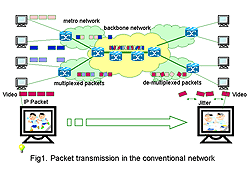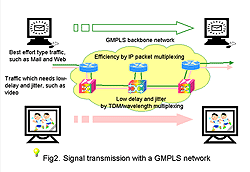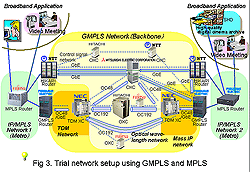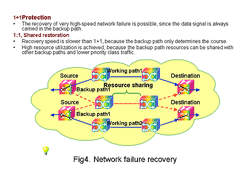 |
(Press Release)
"NTT, NEC, Fujitsu Lab, Furukawa Electric, Hitachi and Mitsubishi Electric succeed in transmitting video across the next-generation photonic network controlled by GMPLS technology"
|
Nippon Telegraph and Telephone Corporation
NEC Corporation
Fujitsu Laboratories Ltd.
The Furukawa Electric Co., Ltd.
Hitachi, Ltd.
Mitsubishi Electric Corporation
|
Nippon Telegraph and Telephone Corporation (NTT; Head Office: Chiyoda-ku, Tokyo; President: Norio Wada), NEC Corporation (Office: Minato-ku Tokyo; President: Akinobu Kanasugi), Fujitsu Laboratories Ltd. (Office: Kawasaki-shi; President: Michio Fujisaki), The Furukawa Electric Co., Ltd. (Office: Chiyoda-ku; President: Hiroshi Ishihara), Hitachi, Ltd., (Office: Chiyoda-ku; President, Chief Executive Officer & Director: Etsuhiko Shoyama) and Mitsubishi Electric Corporation (President & CEO: Tamotsu Nomakuchi) have conducted a successful demonstration of freely controlling Gbit/s- class communication circuits by GMPLS (Generalized MultiProtocol Label Switching) technology in our trial photonic network consisting of multi vendor equipment.
The photonic network, which maximizes the potential of high-speed and large-scale optical communication technology, is attracting attention for realizing the next-generation backbone communication network, which must accommodate various communication services, such as IP communication and leased line services. In this experiment, several kinds of GMPLS-supported communication equipment developed in each company were connected to yield a photonic backbone network that is virtually ready for practical introduction. This GMPLS network supports automatic failure recovery so backup paths are activated when communication links or equipment on the working path fail. In the normal state, a backup path can be used to transfer low priority traffic, which significantly boosts resource utilization efficiency. End-to-end high-speed communication through this network was established prior to conducting the video transmission experiments.
The technology to be exhibited will make it possible to highly reliable and economical high-speed and large-scale networks. Only through these advances can the lower-cost transmission of voice and high-resolution video like digital cinema be made feasible.
Our technical achievements and a demonstration of high-resolution digital video transmission will be introduced from January 26 and to 27, 2004 at the Gigabit Network Symposium 2004 (*1) in Tokyo, Japan.
Background
 With the spread of broadband communication, services that use the IP network to transfer voice and video, like VoIP and streaming, are growing every year. Accordingly, the network capacity requirements are increasing rapidly. With the spread of broadband communication, services that use the IP network to transfer voice and video, like VoIP and streaming, are growing every year. Accordingly, the network capacity requirements are increasing rapidly.
Voice and video are formed into IP packets at the user terminal, and are sent to the network. Why the conventional Internet streaming flow demands a network capacity from hundreds of kbit/s to several Mbit/s, the transmission of the data signal of high-resolution video such as Hi-Vision and digital cinema (movie contents saved in digital form) consumes Gbit/s. In the conventional IP network, packets are repeatedly multiplexed with packets from other users at the metro and the backbone networks. Multiplexing packets causes packet waiting which creates fluctuation in the packet arrival time (jitter) at the receiver side. Excessive packet jitter can trigger failure of the video service (Fig.1). The traditional solution to jitter is to set the transmission bandwidth at up to ten times the straight demand of the application. Therefore, it is necessary to enlarge network capacity much faster than required according to the increase in Internet user number and the enhancement of access lines (more demanding services). It is said that increasing network capacity by adding conventional equipment will lead to sharp cost increases and make it hard to maintain reasonable communication charges.
Technical points
MPLS(*2) and GMPLS(*3) are the key technologies to achieve the long-sought broadband and economical network control mechanism.
 MPLS is a traffic control technology for the IP network. GMPLS is an extension of the MPLS concept to the circuit switching network and the optical fiber network. GMPLS enables unified control management of the network layers (packet / TDM(*4) / wavelength / optical fiber). The use of GMPLS unifies the network operations of disparate networks such as the TDM network with its TDM crossconnects and the optical wavelength network with its optical crossconects (OXC), which will yield significant network operation cost reductions. MPLS is a traffic control technology for the IP network. GMPLS is an extension of the MPLS concept to the circuit switching network and the optical fiber network. GMPLS enables unified control management of the network layers (packet / TDM(*4) / wavelength / optical fiber). The use of GMPLS unifies the network operations of disparate networks such as the TDM network with its TDM crossconnects and the optical wavelength network with its optical crossconects (OXC), which will yield significant network operation cost reductions.
GMPLS is a new control technology designed for the next-generation photonic network. GMPLS offers the novel network service of optical wavelength leased-lines allowing users to freely change destination and quality.
Using the network control of GMPLS and the circuit switching concept seen in the telephone network yields traffic flows that can satisfy different service quality demands. The traffic of applications sensitive to delay or jitter is distinguished from best-effort traffic and transmitted separately in the MPLS network. The GMPLS network goes one step further and transmits the traffic flows sensitive to delay or jitter through a TDM network or optical wavelength network. Consequently, the level of packet multiplexing is minimized because no packet multiplexing occurs in these networks, and it becomes possible to dispense with the excessive transmission bandwidth normally use to suppress packet jitter (Fig. 2).
 The trial network setup is shown in Figure 3. It represents a large-scale backbone network connecting metro networks. Metro networks 1 and 2 use MPLS technology and are constructed around MPLS routers produced by Fujitsu Ltd. and Furukawa (GeoStream R920 and FITELnet-G21, respectively). The backbone network use the GMPLS technology in four kinds of equipment; HIKARI routers(*5) by NTT (IP and wavelength), GMPLS routers of FITELnet-G80 by Furukawa (IP and TDM), TDM crossconects of SpectralWave U-Node by NEC (TDM and wavelength), optical crossconects by Mitsubishi Electric, Hitachi, Fujitsu Laboratories, and NTT (wavelength and optical fiber). The bracketed expressions indicate the function and the layer handled by each company's equipment. GMPLS control software that can handle at least two layers was developed and implemented by each company. These GMPLS equipment are connected using control links (to exchange control messages holding routing information) and data links with over gigabit rate (Gigabit Ether, OC48, and OC192). The trial network setup is shown in Figure 3. It represents a large-scale backbone network connecting metro networks. Metro networks 1 and 2 use MPLS technology and are constructed around MPLS routers produced by Fujitsu Ltd. and Furukawa (GeoStream R920 and FITELnet-G21, respectively). The backbone network use the GMPLS technology in four kinds of equipment; HIKARI routers(*5) by NTT (IP and wavelength), GMPLS routers of FITELnet-G80 by Furukawa (IP and TDM), TDM crossconects of SpectralWave U-Node by NEC (TDM and wavelength), optical crossconects by Mitsubishi Electric, Hitachi, Fujitsu Laboratories, and NTT (wavelength and optical fiber). The bracketed expressions indicate the function and the layer handled by each company's equipment. GMPLS control software that can handle at least two layers was developed and implemented by each company. These GMPLS equipment are connected using control links (to exchange control messages holding routing information) and data links with over gigabit rate (Gigabit Ether, OC48, and OC192).
Since a wide variety of network equipment (e.g. IP routers and cross connects) will coexist in a GMPLS network, it is essential to verify interoperability between multi-vendor network equipment.
Until now, interoperability tests of GMPLS routing and signaling protocols were conducted only at the control software level. We have successfully realized the distribution and collection of routing information and the setup of paths in the multi-layer and multi-vender environment. It is possible to use the various communication paths provided (packet, TDM, wavelength, and a fiber) according to the communication quality demanded.
 In addition, this GMPLS backbone network supports two functions: seamless connection to the Metro network and high reliability. The former is realized by MPLS and GMPLS interworking technology (*6). This interworking technology was first verified to work in the multi-vender environment in October 2003; a world first. In this experiment, practicality was verified through the use of commercial MPLS routers. The latter is made possible by network failure recovery technology (restoration) that can set up detour paths automatically when failure occurs on a certain communication link or equipment on the working path. The backbone network is robust to network failure. This restoration technology shares a backup path among several working paths. In addition, this backup path is made available for the use of lower priority traffic prior to failure of one of the high priority working paths. Consequently, network resources are used very effectively (Fig. 4). In addition, this GMPLS backbone network supports two functions: seamless connection to the Metro network and high reliability. The former is realized by MPLS and GMPLS interworking technology (*6). This interworking technology was first verified to work in the multi-vender environment in October 2003; a world first. In this experiment, practicality was verified through the use of commercial MPLS routers. The latter is made possible by network failure recovery technology (restoration) that can set up detour paths automatically when failure occurs on a certain communication link or equipment on the working path. The backbone network is robust to network failure. This restoration technology shares a backup path among several working paths. In addition, this backup path is made available for the use of lower priority traffic prior to failure of one of the high priority working paths. Consequently, network resources are used very effectively (Fig. 4).
This experiment has successfully transmitted high-resolution video like digital cinema across MPLS and GMPLS networks. It confirms the feasibility of establishing an economical and highly-reliable IP network that offers high-resolution video transmission at reasonable cost.
The GMPLS equipment of NEC and Hitachi in this experiment include the results of research sponsored by TAO (Telecommunications Advancement Organization of Japan).
Future plan
This experiment was carried out by the Photonic Internet Lab (PIL) (*7). PIL has already conducted interoperability tests of a standard GMPLS protocol with a number of global companies at the interoperability site of ISOCORE at Washington D.C, USA. PIL will promote the creation of new control technologies that can be accepted as international standards and the development of novel network services.
<Glossary>
- Gigabit Network Symposium 2004
Symposium for publicizing the research-and-development results for the last five years of work on the Japan Gigabit Network (JGN), and promoting related research the exchange of information between fields. JGN is the research network constructed by TAO.
- MPLS (Multi Protocol Label Switching)
The abbreviation of Multi-protocol Label Switching. MPLS is a packet transmission control technology for the IP network. MPLS realizes traffic control in the IP network. Using the circuit-switching concept seen in the telephone network, it establishes and handles traffic flows that satisfy different service quality demands. At present, MPLS technology is being used to realize traffic management in Internet service providers and to realize IP-VPN services.
- GMPLS(Generalized Multi-Protocol Label Switching)
GMPLS is a protocol that establishes generalized MPLS in all layers of the IP network: layer 2, TDM (Time Division Multiplexing), wavelength (WDM), and the fiber. MPLS attaches fixed length labels to IP packets. GMPLS is attracting attention for controlling the next-generation photonic network. Standardization of GMPLS is being advanced mainly by IETF (The Internet Engineering Task Force). The basic function of GMPLS was released as a Proposed Standard in February 2003, with registration number RFC 3471-3473. In order to make it a complete and truly practical protocol, world-wide efforts are needed to elaborate the remaining details and develop protocol code that can be directly installed in network equipment.
- TDM
Transmitting technology based on time division multiplexing. SDH/SONET is used widely in many networks.
- HIKARI router
A communication device with Terabit (1 trillion bits) -class capacity. It is based on the GMPLS concept and controls MPLS and wavelength paths dynamically and systematically according to changes in IP traffic
- GMPLS and MPLS interworking technology
Permits the interworking of MPLS and GMPLS networks through the use of a newly developed routing interworking function. Because this approach allows the MPLS side to recognize required IP nodes inside the GMPLS domain, GMPLS domain resources can be efficiently managed from the MPLS domain, such as shortest path setup and traffic control.
- Photonic Internet
Lababbreviation: PIL See http://www.pilab.org/
PIL, which was founded in September 2002, is promoting research into and the development of next-generation photonic network technologies. PIL encourages the submission of proposals from its members to global standardization bodies, like ITU-T, IETF, and OIF. PIL also tests the photonic network control programs developed by PIL member companies. This experiment directly supports these goals. At present, PIL consists of seven companies; Oki Electric Industry Co., Ltd. and the six above-mentioned companies. In this experiment, Hitachi Communication Technologies Ltd., which is a subsidiary company of Hitachi, Ltd., received the cooperation of Hitachi, Ltd.
PIL activities are supported by the R&D support scheme of the MPHPT (Ministry of Public Management, Home Affairs, Posts and Telecommunications) for funding selected IT activities.
For further information, please contact:
Minako Sawaki, Hirofumi Motai
Planning Division
NTT Science and Core Technology Laboratory Group
Tel: +81-46-240-5152
E-mail: st-josen@tamail.rdc.ntt.co.jp
Chris Shimizu
NEC Corporation
Tel: +81-3-3798-6511
E-mail:yc-shimizu@cb.jp.nec.com
Network Architecture Laboratory
Network Systems Laboratories
Fujitsu Laboratories Ltd.
Tel: +81-44-754-2765
E-mail:gmpls@ml.labs.fujitsu.com
Yukihiro Kuwamoto, Osamu Suzuki
Public Relations Section
The Furukawa Electric Co., Ltd.
TEL: +81-3-3286-3050
E-mail:pub@ho.furukawa.co.jp
Naoko Okada
Communications
Information & Telecommunication Systems
Hitachi, Ltd.
TEL: +81-3-5471-8900,Fax: +81-3-5471-8931
E-mail: koho@itg.hitachi.co.jp
Oliver Cox
Public Relations Department
Mitsubishi Electric Corporation
TEL: +81-3-3218-2346
E-mail:Oliver.Cox@hq.melco.co.jp
|
|
All company/product names mentioned may be trademarks or registered trademarks of their respective holders and are used for identification purpose only.
Please understand that product prices, specifications and other details are current on the day of issue of the press release, however, may change thereafter without notice.

|
 |

